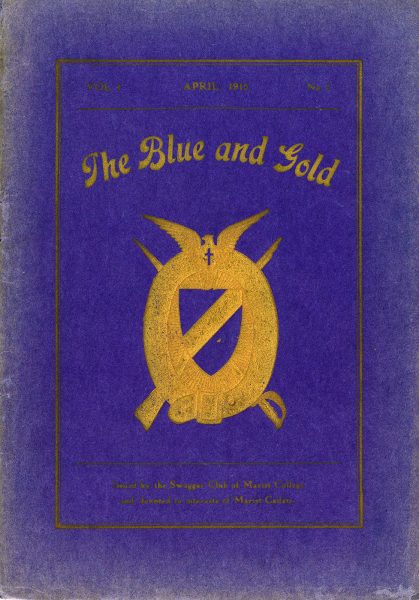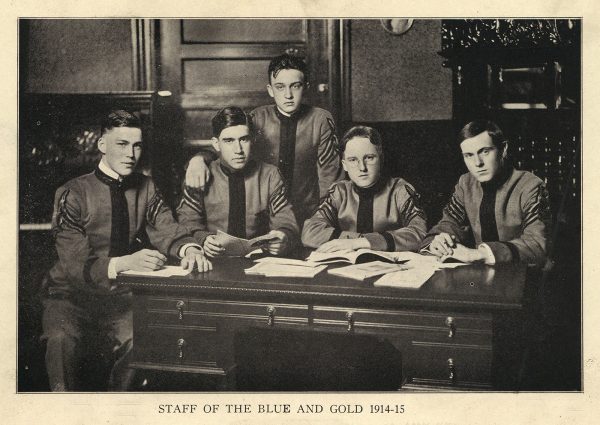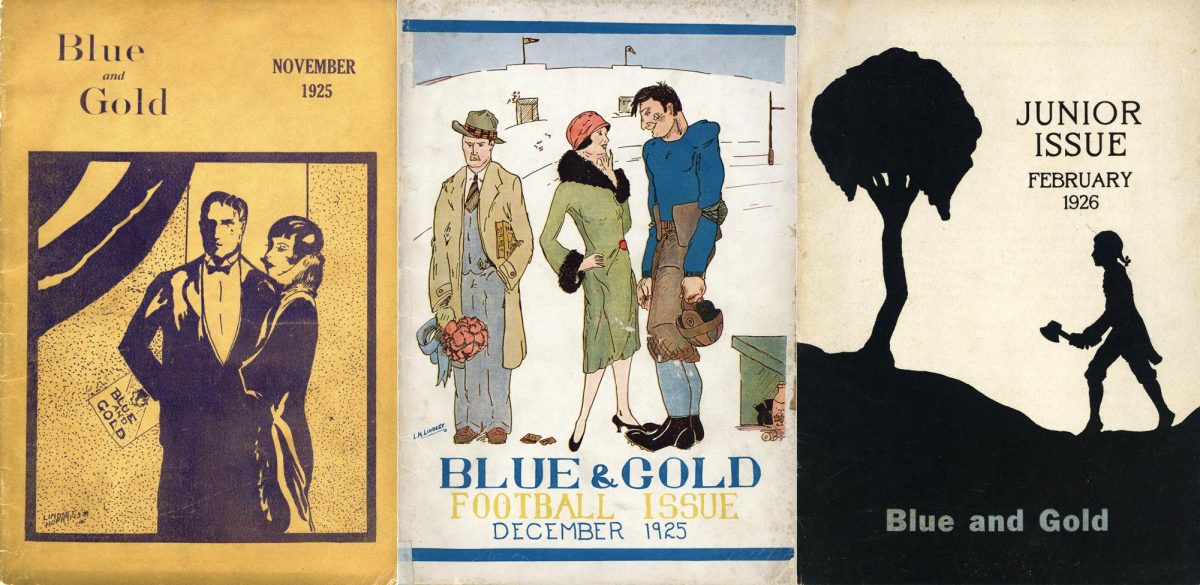Our History
ORIGINS

The earliest surviving issue of The Blue & Gold (Volume 1, Number 7) appeared in print in APRIL 1915. The volume number indicates the publication started as early as September 1914. The publication appeared in booklet form with cover material consisting of gold gilt on blue felt paper.
The earliest issues were produced by a group of students known as The Swagger Club, an association of student officers among the cadets of Marist College, an all-boy military academy at the time. The first editor-in-chief was senior cadet P. Saxton Lewis, a graduate of 1915, and Rev. Daniel F. Sullivan, S.M. acted as the first faculty director.
The Blue & Gold began as a student-driven enterprise. Staff members led the writing, editing, and financing sides of the operation. The editor-in-chief and associate editor oversaw the content and design of the publication while editors of classes submitted news reports from the different grade levels. Other staff members held positions such as sports editor, artist, business manager, and advertising manager.
Any student wishing to submit a story could do so. Readers purchased individual issues for 10 cents or bought a ten-month “mailed” subscription for $1.00.

The earliest issues contained a loose collection of student fiction, editorials, news reports, and honor recognitions, among other pieces such as poetry and letters. The staff had not yet adopted a recurring format nor made reporting school news their primary focus.
The April 1915 issue, for example, featured a reprint of an appeal written by Secretary of the NRA Lt. Albert S. Jones, urging schools and colleges across the nation to establish riflery instruction programs. “The more a boy knows of what war means, and the terrible destructive powers of a military rifle,” Jones explained, “the less eager he will be to urge his country into conflict with another nation.”
Similar appeals written by Jones had already appeared in various publications as early as 1903.
The MARCH 1917 issue includes a letter from Rev. L. L. Dubois, S.M., a former faculty member writing from war-torn France where he served as an ambulance driver. Dubois’ account includes the censorship redactions customary during World War I:
News reports were written as brief announcements rather than complete stories. One announcement from an early issue, for example, reported that Tulane University will offer a scholarship to the senior cadet with the highest marks. Another announcement lamented the low scores in French class among junior cadets.
FICTION & EDITORIALS
Throughout the early publication of The Blue & Gold, student fiction and editorials were the primary features found on its pages. It is best to think of the publication at this time as a magazine rather than a newspaper. The staff considered it so and used the term regularly.
Much of the fiction that appeared in the magazine were the kinds of stories that would appeal to adolescents attending an all-boy military academy. From the NOVEMBER 1921 issue, we have “The Den of Mystery” by junior cadet Victor Corrigan. Readers of the FEBRUARY 1927 issue enjoyed “The Bigger They Come, the Harder They Fall” by junior cadet Eugene A. Murphy. Swashbuckling tales of adventure, mystery, and unlikely victories were common.
Some contributors even serialized longer stories over multiple issues.
Early editorials reveal an awareness of the world beyond the boundaries of Marist College and the school’s position within it. Written against the backdrop of the multiple peace conferences that followed World War I, an anonymous editorial from FEBRUARY 1922 ponders the role of military academies like Marist College in a world striving for lasting peace:
Other editorials encouraged the development of personal character. Staff writers regularly explored ideas meant to instill maturity among the student body, such as the benefits of cooperation, the importance of courtesy, and the true meaning of loyalty.
In FEBRUARY 1923, senior cadet Arthur Altmayer congratulated the film industry for the educational value of moving pictures. In FEBRUARY 1927, junior cadet Eugene A. Murphy warned his schoolmates against the dangers of a “tight mind,” a mentality ill-suited for embracing new experiences or overcoming unexpected challenges.
VISUAL ART
In the early years, The Blue & Gold occasionally served as an outlet for visual artistic expression.
From NOVEMBER 1925 to MAY 1926, Staff Artist Lindsey Hopkins, Jr. brought visual art to the covers and pages of the magazine. For these issues, the editors broke away from the repetitive blue-and-gold cover design in favor of vivid depictions of school life. Sketches by Hopkins also made regular appearances on the pages of the magazine.

A graduate of 1923, Hopkins later received the Marist School Distinguished Alumni Award in 1984.
FORMAT
The staff gradually adopted – more or less – a recurring format for the magazine. The publication already included a healthy dose of fiction, editorials, and news announcements. The staff added more expansive sports coverage and a section devoted to humorous anecdotes that sometimes teased schoolmates by name.
From the pages of the DECEMBER 1925 issue, for example, readers learned that “Pierotti has resumed his old position of disinfecting the classroom every morning. His taste in hair tonics is appreciated by all the professors.” More banter from the MARCH-APRIL 1926 issue reads, “I’d tell you what the band sounds like, but I’m afraid the members of the band would get rough.”
One new section was titled “Exchanges.” As a way to improve the quality of the magazine, the staff exchanged copies of The Blue & Gold for other school publications. Those schools, in return, sent to Marist College their own magazines along with some constructive criticism for the editors of The Blue & Gold.
The staff exchanged publications with many local high schools and colleges, including the Georgia School of Technology, which later became Georgia Tech, and Boys High School, now known as Midtown High School.
The staff also searched far beyond their local community for feedback. As part of their efforts to improve The Blue & Gold, they exchanged publications with schools as far away as Cleveland, Minneapolis, and Seattle.


